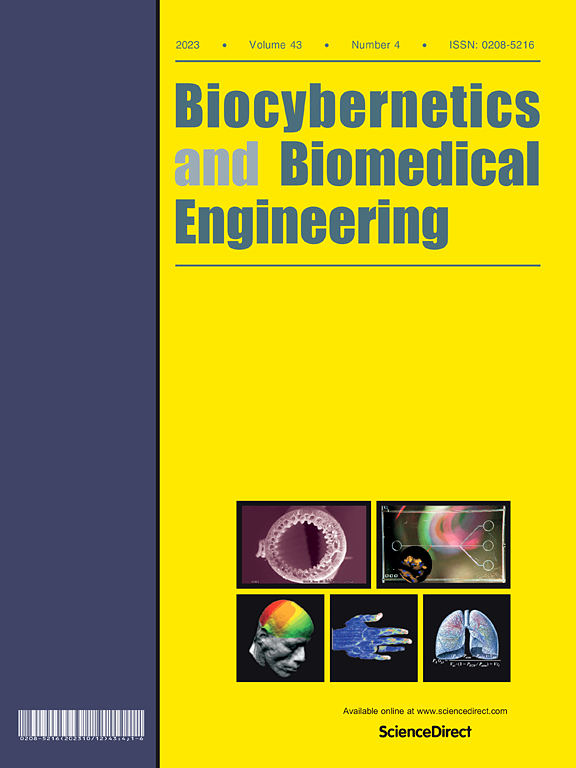Spatio-temporal matched filter adjustment for enhanced accuracy in brain responses classification
IF 6.6
2区 医学
Q1 ENGINEERING, BIOMEDICAL
引用次数: 0
Abstract
In this paper, we apply modified spatio-temporal matched filtering (MSTMF) to enhance electroencephalographic (EEG) signals in evoked potentials (EP) based brain–computer interfaces (BCI). Our focus is on the effective treatment of noise in the system under consideration.
The applied MSTMF is a spatio-temporal extension of generalized matched filtering, which allows for optimal enhancement of weak, repeatable signals embedded in colored Gaussian noise. However, since spontaneous EEG signals are often corrupted by high-energy super-Gaussian artifacts, which deviate from this distribution, we propose rejecting these artifacts before applying MSTMF. Particularly effective have been algorithms based on independent component analysis (ICA) and empirical mode decomposition (EMD). After artifacts rejection, performed locally within time segments they occupy, without disturbing other parts of the signal, the classification of brain responses becomes more accurate. Nevertheless, the nonstationarity of the EEG signal remains a challenge that must be addressed.
Therefore, we propose adjusting the MSTMF to the current noise properties to improve its performance in this demanding environment. This can be achieved by properly calculating the noise covariance matrix, which is necessary to determine the filter coefficients, using both the learning and currently processed signal segments.
As a result, we have developed an enhanced method based on MSTMF for improved discrimination of evoked potentials and verified its performance on two publicly available reference databases: BCIAUT-P300 (for IFMBE Scientific Challenge) and Speller (for the BCI Competition III Challenge 2004). For these databases, we have achieved overall accuracies of 92.67% and 99.5%, surpassing the reference methods presented in the literature.
提高脑反应分类准确性的时空匹配滤波调整
本文采用改进的时空匹配滤波(MSTMF)增强基于诱发电位(EP)的脑机接口(BCI)中的脑电图(EEG)信号。我们的重点是如何有效地处理系统中的噪音。所应用的MSTMF是广义匹配滤波的时空扩展,它允许嵌入在彩色高斯噪声中的弱、可重复信号的最佳增强。然而,由于自发脑电信号经常被偏离这种分布的高能超高斯伪影破坏,我们建议在应用MSTMF之前拒绝这些伪影。特别有效的是基于独立成分分析(ICA)和经验模式分解(EMD)的算法。在排除伪影后,在不干扰信号的其他部分的情况下,在它们占据的时间段内局部执行,大脑反应的分类变得更加准确。然而,脑电信号的非平稳性仍然是一个必须解决的挑战。因此,我们建议调整MSTMF以适应当前的噪声特性,以改善其在这种苛刻环境中的性能。这可以通过适当地计算噪声协方差矩阵来实现,这是确定滤波器系数所必需的,同时使用学习和当前处理的信号段。因此,我们开发了一种基于MSTMF的增强方法来改进诱发电位的区分,并在两个公开可用的参考数据库上验证了其性能:BCIAUT-P300(用于IFMBE科学挑战赛)和Speller(用于2004年BCI竞赛III挑战赛)。对于这些数据库,我们达到了92.67%和99.5%的总体准确率,超过了文献中提出的参考方法。
本文章由计算机程序翻译,如有差异,请以英文原文为准。
求助全文
约1分钟内获得全文
求助全文
来源期刊

Biocybernetics and Biomedical Engineering
ENGINEERING, BIOMEDICAL-
CiteScore
16.50
自引率
6.20%
发文量
77
审稿时长
38 days
期刊介绍:
Biocybernetics and Biomedical Engineering is a quarterly journal, founded in 1981, devoted to publishing the results of original, innovative and creative research investigations in the field of Biocybernetics and biomedical engineering, which bridges mathematical, physical, chemical and engineering methods and technology to analyse physiological processes in living organisms as well as to develop methods, devices and systems used in biology and medicine, mainly in medical diagnosis, monitoring systems and therapy. The Journal''s mission is to advance scientific discovery into new or improved standards of care, and promotion a wide-ranging exchange between science and its application to humans.
 求助内容:
求助内容: 应助结果提醒方式:
应助结果提醒方式:


